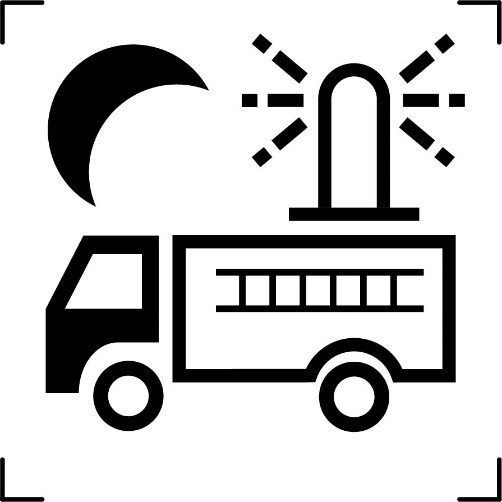FAMA BUYER’S GUIDE TC078 Warning Lights Night Mode
Warning Lights Night Mode
Prepared by the FAMA Electrical Subcommittee
This guide does not endorse any manufacturer or product

Contents
Introduction
The progression of high intensity LED warning lights has caused concern over the warning lights being too bright during nighttime. During code 3 operation it is important that drivers are alerted to emergency apparatus approaching quickly. However, during blocking mode, we want drivers to remain undistracted and attentive while passing the scene, with all their faculties and vision optimized for safe driving.
The NFPA apparatus committee began debating new requirements to address this concern, but new criteria will not be available from NFPA until 2023. This FAMA Buyer’s Guide provides guidance until the NFPA makes changes to the standard.
The Problem
The current NFPA 1901 and 1906 standards for apparatus warning lights were developed in an era prior to the advent of LED lighting. At that time and with the technology available, the standard was only concerned with making sure the lights were bright enough, not whether they were ever too bright.
Today’s LED technology, however, has changed the discussion. A typical apparatus with LED lighting today could emit lighting levels easily ten times the minimum level specified in the NFPA standards.
During the day, warning light levels can never be too great, because they are competing with the sun. Daylight constricts the observer’s pupil and very bright warning lights do not seem so bright compared to the surrounding environment. At night, however, the pupil dilates to let in as much of the sparse light as possible. When suddenly submitted to the intense light levels given off by modern LED warning lights, the result can be very distracting, even blinding, to people in the vicinity.
Some argue that bright flashing lights at a roadside scene may be detracting rather than adding to scene safety. Drivers distracted by the intense light levels may be less likely to see the details of people working around the area. First responders may also be distracted by the lighting levels as they work on the scene.
The key aspects of warning light operation in nighttime operations are Intensity, Flash Pattern and Frequency, Synchronization, and Flash Ramp Rate.
Intensity
Subjective studies by the Emergency Responder Safety Institute (ERSI) in June of 2019 suggest that even at intensity levels well below the minimum NFPA requirements, warning lights at nighttime are very visible and perhaps still higher than necessary. The ability to have a predetermined dim level for warning lights is available from most warning light manufacturers in at least some of their warning light families. A warning light night mode switch that dims the warning lights can be specified and provided with fairly simple electrical wiring using currently available warning lights.
Flash Pattern and Frequency
There is subjective evidence to suggest that fast, frenetic, and random flash patterns are not the most optimum strategy, at least for nighttime warning, and perhaps never while in the blocking mode. Warning light flash rates should be specified as close as possible to the NFPA 1901 minimum of 75 flashes per minute.
The ability to provide alternate flash patterns for day and night modes is technically possible, but at the time of publication of this Buyer’s Guide requires significant addition of complexity and cost to the apparatus electrical system.
Flash Ramp Rate
The nature of incandescent lighting is that its intensity comes on gradually (relatively speaking) as the filament heats up. Rotation beacons also have a gradual on, gradual off characteristic as the beam rotates in and out of the observer’s vision.
LED light without any ramp programming comes on instantly. Subjectively, this is harder on the human eye and brain, giving a much harsher feel to the lighting. This had been shown to increase the emotional response of the observer and can increase their level of distraction.
This technology may be considered by the NFPA committee and may become more readily available in the coming years. At that time of publication of this Buyer’s Guide, the feature is not readily available on most commercial warning lights.
Synchronization
Subjectively, it can be possible in low-light situations to temporarily lose track of an emergency vehicle as its warning lights cycle on and off during the flashing operation. In blocking at night mode, alternating warning lights in a synchronized pattern allows drivers approaching the vehicle to be aware of the location of the emergency vehicle constantly.
The ability to provide synchronized flash patterns for blocking at night modes is technically possible, but at the time of publication of this Buyer’s Guide requires significant addition of complexity and cost to the apparatus electrical system.
Night Mode Control
If the apparatus is going to have a warning light night mode, it can be controlled manually, or automatically. Automatic control could be tied to the time of day (coming on at dusk and off at dawn), or by a light sensor measuring the ambient lighting. The NFPA Apparatus Committee has been considering requiring a light sensor, but the jury is still out. How well a light sensor would work at a scene with multiple trucks and the potential for high-intensity scene lighting is not well understood at this time. Until the NFPA completes their study and debate, FAMA recommends that a night mode function be controlled by the operator using a manual switching device.
FAMA Recommendation
All the things discussed so far are technically feasible, but they are not all commercially available or practical. Until the NFPA apparatus committee makes changes to the standard, FAMA recommends that fire departments wishing to include a night mode for warning lights on their apparatus use the following specification language.
The apparatus shall include a warning light night mode switch which when activated shall reduce the intensity of the warning lights so long as it is not below the minimum intensity required by NFPA 1901 Standard for Automotive Fire Apparatus.
This language will provide a night mode that is still NFPA compliant, even during the nighttime. It is a manual switch, putting the operator in control, and avoiding the technical complications associated with multiple flash patterns, flash ramping, synchronization, and automatic sensing.

